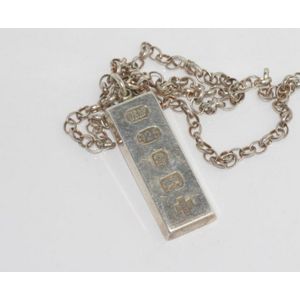Edwardian Ivy Engraved Silver Snuff Box
An Edwardian silver rectangular snuff box, in the Georgian style, the base and hinged lid with ivy engraved leaf decoration, circular large vacant cartouche. Birmingham 1909 Gloster Ltd. Provenance: The Flower Family Collection. Length 4.5 cm
You must be a subscriber, and be logged in to view price and dealer details.
Subscribe Now to view actual auction price for this item
When you subscribe, you have the option of setting the currency in which to display prices to $Au, $US, $NZ or Stg.
This item has been sold, and the description, image and price are for reference purposes only.
- Edwardian - The Edwardian period of English furniture and decorative arts design is named for Edward VII (1841 ? 1910) who was King of the United Kingdom and the British Dominions and Emperor of India for the brief period from 1901 until his death in 1910. It follows the Victorian period, in turn was followed by the Art Nouveau and Art Deco styles. In Australia, designs of this period are also known as being in the Federation style.
- Cartouche - An ornamental panel in the form of of a shield, oval or rectangular scroll with curling edges. It may be carved into the back of a chair or the top of a sideboard, or present on a piece of silver or jewellery, and contain the initials of the original owner, heraldic symbols, or some other inscription, such as the details of a presentation.
In ceramics the term defines the central area of a vase or similar with a decorative border in one of the shapes above, into which a decorative scene or figures have been painted. - Georgian - As an English stylistic period, Georgian is usually taken to cover the period from George I (1714) to the Regency of Prince George (1811-20), although the period from 1800 to 1830 is sometimes designated as the Regency period. During the Georgian period the great English cabinetmakers and designers such as Chippendale, Hepplewhite, Adam Sheraton etc., were all active.
Therefore there isn't a single 'Georgian style' as such and to say something is 'Georgian', usually means it was made between 1714 and 1830. This assumes we discount George V and George VI, both being from the 20th century.
The styles popular at the time of each reign were:
George I (1714-1727) saw out the last years of the Baroque period.
George II (1727-1760) reigned during the Rococo period.
George III (1760-1820) saw the last gasp of the Rococo, all of the early Neo-Classic 'Adam style' and most of the later neo-Classic 'Regency style'.
George IV (Prince Regent 1820-1830)encompassed the last of the 'Regency' style.
William IV's reign (1830-1837) was something of a no man's land (stylistically) and he wasn't a 'George' anyway. He covered the last glimmerings of 'Regency' and the start of the 'Victorian' style.
This item has been included into following indexes:
Visually similar items

English hallmarked silver ingot on silver chain, weight approx 40.85 grams
Sold by
in
for
You can display prices in $Au, $US, $NZ or Stg.

Vintage Longines 18ct white gold & diamond cocktail watch
Sold by
in
for
You can display prices in $Au, $US, $NZ or Stg.

An antique ruby and diamond ring, square panel, one ruby missing, set in silver. Ring size P. A/f.
Sold by
in
for
You can display prices in $Au, $US, $NZ or Stg.

Two silver bracelets; one attached with assorted charms other with blue enamelled bells (clasp deficient). Wt. 68.5g
Sold by
in
for
You can display prices in $Au, $US, $NZ or Stg.
